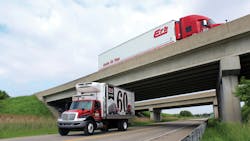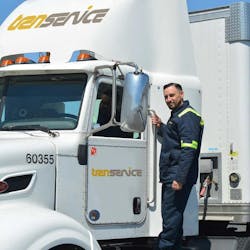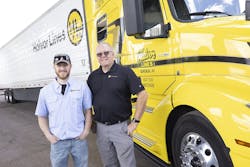This is the first part of a two-part series looking at how fleets have found success operating heavy- and medium-duty equipment and managing drivers with different skills and jobs. Part two will be linked here when it runs later this week.
Finding the right fit and training program for mixed fleets can be challenging for those who try to treat each job and each driver’s experience the same.
“Carriers often lack the time and resources they need to segment driver training,” said Dr. Gina Anderson, CEO at Luma Brighter Learning. “But those that do approach training in terms of the different types of vehicles they have and the different parts of their operations realize higher levels of engagement and improved safety.”
“There is a real need for training drivers differently,” Anderson told FleetOwner. “Most fleets train all drivers using the same content and programs. What they need to do is put trainees in the environment in which they will be working every day. Training content is important, but differentiated learning is critical for retention of information.”
With targeted and customized training, differently classified drivers can be provided with information about specific types of vehicles, operations, and customer locations. At the same time, Anderson related that an immersive learning approach uses content in different ways and promotes an interactive learning experience that bolsters engagement.
“Another part of successful training is to understand how adults learn,” Anderson stated. “Adults bring knowledge and experiences with them and different cadences in understanding material. They have a specific way of wanting to learn, and that means the same information presented in the same way is not always the most effective approach.”
“Immersive learning is a more effective way of bringing the environment they have to know and perform in to students,” she added. “Carriers can build immersive learning by thinking about the content they’re providing in different ways. A platform that offers different ways to learn, such as online and in-person classes, drives the ability to provide more powerful and meaningful training programs.”
Addressing different training needs
Fleets with a mix of equipment and operations should recognize that they also have various driver training needs, noted Mark Murrell, co-founder of CarriersEdge. “There are differences in types of equipment, areas of operation, and trip planning,” he said. “There are also specialized training needs for newer and more experienced drivers.”
Murrell went on to point out that one common misconception among mixed fleets is that less training is needed for drivers of smaller vehicles.
“Drivers of different types of commercial vehicles have equal but different risks and responsibilities,” he told FleetOwner. “For example, while there are distractions in on-highway operations due to complacency while spending long hours on the road, local drivers face surroundings with pedestrians and other vehicles.”
According to Murrell, carriers should consider how they assign routes and equipment to new drivers compared to more experienced operators. Newer drivers, for example, might end up working in areas requiring a higher level of expertise, which may prevent them from getting the needed practice.
“Overall,” Murrell added, “part of the key to successful training is to understand your different risks and realize they are all important to address.”
See also: Freight recession continues with low rates, volumes
Carriers are employing successful approaches
For carriers across North America, successfully meeting different driver training needs begins with the essentials. Common topics include regulatory requirements, distracted driving, trip planning, accident management, and lifestyle issues such as fatigue management and health and wellness, among others.
Additionally, fleets are focusing on training drivers for different vehicle types and for specific operations. Addressing these challenges with targeted training lowers risk and improves safety. FleetOwner spoke with several fleets running medium- and heavy-duty equipment with CDL and non-CDL drivers to see how they approach training.
Transervice
Being a driver at Transervice is not just about being behind the wheel. That thinking—part of the approach to driver training at the Lake Success, New York-based company—fits with the ability to provide a range of freight hauling services and field 525 tractors and 1,800 trailers at 21 facilities across North America.
“Hauling dedicated freight means we’re contracting with companies that have a wide array of needs,” said Mark Finger, VP of operations. “Our approach to training drivers takes into account that broad spectrum of customers and different types of operations. Likewise, as it relates to advancing employees to become drivers, there are also different CDL training requirements that may vary by state to consider.”
When asked to describe the range of freight that Transervice hauls, Finger said it runs from live hogs to commercial garage doors and everything in between. That means operating a variety of trailers, including some with specialized equipment for loading, unloading, and securing loads.
“Our roughly 700 drivers all start training with a wide view of things like hours-of-service regulations, and our safety department takes them through materials we’ve developed internally,” Finger related. “Training is provided for common topics such as space management and is also tailored to local, regional, and long-haul operations, and load securement in different types of equipment.”
Finger noted that ongoing communication with Transervice drivers keeps them engaged and makes safety awareness top of mind. Training is also continually evolving. “We’re using technology like in-cab cameras and telematics data to develop coaching opportunities that enable our drivers to continually improve their performance,” he said.
Halvor Lines
Halvor Lines firmly believes that driver satisfaction helps drive the company’s success. Bob Knaeble, senior CDL training manager, noted the diversified carrier’s approach to training is focused on professionalism and a commitment to on-time deliveries.
Headquartered in Superior, Wisconsin, Halvor Lines is a family-run trucking company that provides flatbed, van, decked van, and refrigerated services. It fields more than 400 tractors across the continental U.S. and Canada through seven Midwestern terminals.
Halvor Lines' drivers undergo a series of training courses geared toward specific aspects of the carrier’s operation. For example, there are classes on flatbed cargo securement and proper loading of ATVs when hauling loads for motorsports customers. In addition, all drivers must take eight hours of paid training in the Smith System defensive driving course with one of the company’s five certified instructors.
“Our training continues to evolve, but a common thread has been to work with CarriersEdge,” Knaeble said. “We use their online driver training modules for new driver orientation and continuing education, and some of our own content is deployed through their platform. That is one of the reasons we chose CarriersEdge.”
Orientation modules provided by CarriersEdge to Halvor Lines drivers cover a range of required topics and company policies, C-TPAT for cross-border operations, and security and threat awareness.
“We also have a safety team that works with drivers individually, and if they see a need for training in one area, they choose from a list of training modules,” Knaeble related. “The refresher courses are taken online through the CarriersEdge portal, which our drivers like since they can use their laptop or tablet when it’s most convenient.”
Before it put the CarriersEdge online platform in place, Knaeble noted, Halvor Lines used safety and training videos. “While that meant drivers saw a video, they didn’t absorb the content,” he said. “With online training and testing, they retain the information.”
About the Author

Seth Skydel
Seth Skydel, a veteran industry editor, has more than four decades of experience in fleet management, trucking, and transportation and logistics publications. Today, in editorial and marketing roles, he writes about fleet, service, and transportation management, vehicle and information technology, and industry trends and issues.


